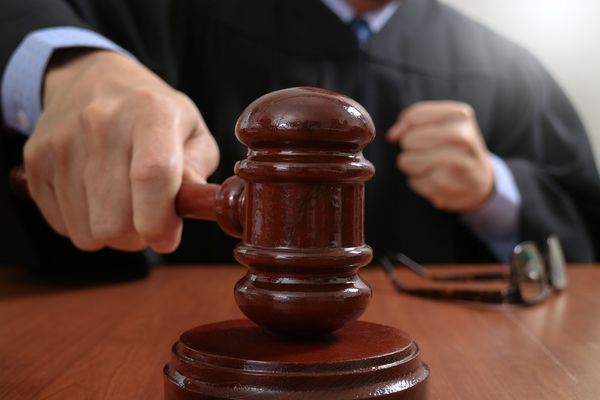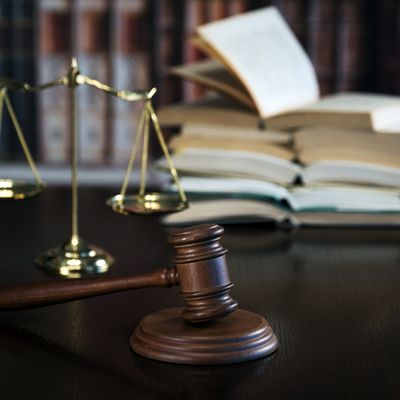2.1.1
Hitler's Consolidation Of Power
Governmental and Administrative Change
Governmental and Administrative Change
Hitler changed Germany's bureaucratic institutions. He first tried to remove all political opponents. By the end of 1933, the Nazis were the only official party. Germany was a single party state.


Courts
Courts
- New People’s Courts and Special Courts were created in March 1933.
- In October 1933 lawyers had to join the German Lawyers’ Front and swear loyalty to Hitler.


Removal of 'alien elements'
Removal of 'alien elements'
- On 7 April 1933 the Law for the Official Reform of the Civil Service was passed. ‘Alien elements’ (Jews, political opponents) were removed from courts, education and the civil service.
- The existing civil service stayed in place but lost influence as the NSDAP increasingly set up its own specialist agencies to develop and execute policies.
Politically removing opponents
Politically removing opponents
- SPD leader Otto Wels fled into exile in June after the party was banned. Other parties dissolved themselves.
- On 14 July Law against the Formation of New Parties.
- In November 1933 NSDAP won 92% of the election votes (8% = spoiled votes)
- In January 1934 the Law for the Reconstruction of the State was passed. Elected state assemblies were dissolved. Reich Governors were created – Nazi Gauleiters often appointed.


Trade Unions
Trade Unions
- On 2 May trades union officials were seized; all trade unions replaced by DAF (Nazi Trade Union).


Violently removing opponents
Violently removing opponents
- The SA murdered about 500 people.
- 100,000 political opponents were arrested.
- From March 1933 the SA had been violently overthrowing many state governments so that the Reich government had to appoint commissioners.
Political threats?
Political threats?
Most generals agreed with Hitler’s ideas about German nationalism, rearmament, and were anti-left wing. Hitler was wary of the army.
Night of the Long Knives 1934
Night of the Long Knives 1934
This was a purge of Hitler's SA and key political opponents. The SA were becoming uncontrollable and Hitler believed they were damaging the reputation of the Nazi party. He replaced them with the more disciplined, SS.


Motives behind the Night of the Long Knives
Motives behind the Night of the Long Knives
- Nazi infighting:
- Himmler wanted the SS removed from SA control.
- Goering resented Röhm and led Hitler to believe Röhm was planning a coup.
- Hitler needed élite support:
- Röhm had spoken of a ‘second revolution’ to fulfil the socialist points of the 25 Point Programme. Hitler feared an élite backlash.
- Papen had publicly criticised the SA, with Hindenburg’s approval.
- The Army disliked the SA. Germany’s military was still run by the élite.


Night of the Long Knives
Night of the Long Knives
- The purge (named Operation Hummingbird) lasted from 29 June to 2 July.
- Overall, about 90 opponents of Hitler were murdered, including over 50 SA leaders.


Impact of the Night of the Long Knives
Impact of the Night of the Long Knives
- The night marks a watershed Hitler’s dictatorship: he crushed the radical SA, murdered his opponents and won the support of the élites – including the army.
- On 3 July 1934, Hitler passed a law legalising the actions having gained acceptance of his actions and legalised the murders of his opponents.
- The SS became independent of the SA and under Hitler’s personal command.


Historical assessment
Historical assessment
- Ian Kershaw (2001) argues that the Night of the Long Knives actually increased public confidence in Hitler as Fuhrer.
- The 'Hitler Myth' is the idea that in the eyes of the millions of people who loved him, Hitler could do no wrong.
- Hitler gave a long speech in the Reichstag a fortnight after the events and justified his actions, describing himself as the 'supreme judge' of the German people.
- His public image was strengthened by the speech. People saw him as a defender of the little man against the big man.
The Death of President Hindenburg
The Death of President Hindenburg
When Hindenburg died, Hitler became the Führer of Germany.


Führer and Reich Chancellor
Führer and Reich Chancellor
- On 1 August 1934, Hitler passed a law concerning the Head of State of the German Reich.
- He merged the offices of President and Chancellor into Führer and Reich Chancellor.


Hindenburg's death
Hindenburg's death
- On 2 August 1934, Hindenburg died.
- Hitler became Führer of Germany.
- As head of the only political party allowed in Germany, all power was in his hands.


Oath to Hitler
Oath to Hitler
- The German Armed Forces took an oath of personal loyalty to Hitler:
- ‘I will render unconditional obedience to Adolf Hitler, the Führer…’.
1The Weimar Republic 1918-1933
1.1Establishment Of The Weimar Republic 1918-1924
1.1.1Post WW1
1.1.2Weimar Constitution
1.1.3Peace Settlement
1.1.4End of Topic Test - Germany Post WW1
1.1.5Economic Issues
1.1.6Economic Issues 2
1.1.7Social Issues
1.1.8End of Topic Test - Economic & Social Issues
1.1.9Extremist Threats
1.1.10Extremist Threats 2
1.1.11End of Topic Test - Extremist Threats
1.1.12Political Instability & The Invasion of the Ruhr
1.1.13Weimar Government by 1924
1.1.14End of Topic Test - Weimar Government by 1924
1.1.15A-A* (AO3/4) - Germany Post WW1
1.2The 'Golden Age' Of The Weimar Republic 1924-1928
1.2.1Economic Developments
1.2.2Industry & Agriculture
1.2.3End of Topic Test - Economic Developments
1.2.4Social Developments
1.2.5Social Developments 2
1.2.6End of Topic Test - Social Developments
1.2.7Political Parties
1.2.8Political Stability
1.2.9End of Topic Test - Weimar Politics
1.2.10Germany's International Position
1.2.11Germany's International Position 2
1.2.12End of Topic Test - International Position
1.2.13A-A* (AO3/4) - The Weimar 'Golden Age'
1.3The Collapse of Democracy 1928-1933
1.3.1The Impact Of The Depression
1.3.2Politics After The Depression
1.3.3The Appeal Of Extremism
1.3.4End of Topic Test - The Depression & Politics
1.3.5'Backstairs Intrigue'
1.3.6'Backstairs Intrigue' 2
1.3.7End of Topic Test - Backstairs Intrigue
1.3.8Political Developments
1.3.9The State by March 1933
1.3.10End of Topic Test - Political Developments
1.3.11A-A* (AO3/4) - The Collapse of Democracy
2Nazi Germany 1933-1945
2.1The Nazi Dictatorship 1933-1939
2.1.1Hitler's Consolidation Of Power
2.1.2The Terror State
2.1.3End of Topic Test - Consolidation of Power
2.1.4Opposition
2.1.5Propaganda
2.1.6A-A* (AO3/4) - Terror State & Propaganda
2.1.7End of Topic Test - Propaganda
2.1.8Economic Policies
2.1.9Economic Policies 2
2.1.10Impact Of Economic Policies
2.1.11Impact Of Economic Policies 2
2.1.12End of Topic Test - Economic Policies
2.1.13Social Policies
2.1.14Social Policies 2
2.1.15Volksgemeinschaft
2.1.16End of Topic Test - Social Policies
2.1.17A-A* (AO3/4) - Economic & Social Policies
2.2The Racial State 1933-1941
2.2.1The Radicalisation Of The State
2.2.2Anti-Semitism
2.2.3Development Of Anti-Semitic Policies
2.2.4Development Of Anti-Semitic Policies 2
2.2.5End of Topic Test - Anti-Semitism
2.2.6Treatment of the Jews in the Early Years of War
2.2.7Deportation & Anti-Semitism Evaluation
2.2.8End of Topic Test - Early Treatment of the Jews
2.2.9A-A* (AO3/4) - The Racial State
2.3The Impact Of War 1939-1945
2.3.1Home Front
2.3.2Impact On Society
2.3.3Impact On Society 2
2.3.4End of Topic Test - Impact of the War
2.3.5War Economy
2.3.6War Economy 2
2.3.7Policies Towards The Jews & Untermenschen
2.3.8A-A* (AO3/4) - Impact of the War
2.3.9End of Topic Test - War Economy
2.3.10Opposition
2.3.11Opposition 2
2.3.12Nazi State by 1945
2.3.13End of Topic Test - Opposition
2.3.14A-A* (AO3/4) - Opposition & The State in 1945
Jump to other topics
1The Weimar Republic 1918-1933
1.1Establishment Of The Weimar Republic 1918-1924
1.1.1Post WW1
1.1.2Weimar Constitution
1.1.3Peace Settlement
1.1.4End of Topic Test - Germany Post WW1
1.1.5Economic Issues
1.1.6Economic Issues 2
1.1.7Social Issues
1.1.8End of Topic Test - Economic & Social Issues
1.1.9Extremist Threats
1.1.10Extremist Threats 2
1.1.11End of Topic Test - Extremist Threats
1.1.12Political Instability & The Invasion of the Ruhr
1.1.13Weimar Government by 1924
1.1.14End of Topic Test - Weimar Government by 1924
1.1.15A-A* (AO3/4) - Germany Post WW1
1.2The 'Golden Age' Of The Weimar Republic 1924-1928
1.2.1Economic Developments
1.2.2Industry & Agriculture
1.2.3End of Topic Test - Economic Developments
1.2.4Social Developments
1.2.5Social Developments 2
1.2.6End of Topic Test - Social Developments
1.2.7Political Parties
1.2.8Political Stability
1.2.9End of Topic Test - Weimar Politics
1.2.10Germany's International Position
1.2.11Germany's International Position 2
1.2.12End of Topic Test - International Position
1.2.13A-A* (AO3/4) - The Weimar 'Golden Age'
1.3The Collapse of Democracy 1928-1933
1.3.1The Impact Of The Depression
1.3.2Politics After The Depression
1.3.3The Appeal Of Extremism
1.3.4End of Topic Test - The Depression & Politics
1.3.5'Backstairs Intrigue'
1.3.6'Backstairs Intrigue' 2
1.3.7End of Topic Test - Backstairs Intrigue
1.3.8Political Developments
1.3.9The State by March 1933
1.3.10End of Topic Test - Political Developments
1.3.11A-A* (AO3/4) - The Collapse of Democracy
2Nazi Germany 1933-1945
2.1The Nazi Dictatorship 1933-1939
2.1.1Hitler's Consolidation Of Power
2.1.2The Terror State
2.1.3End of Topic Test - Consolidation of Power
2.1.4Opposition
2.1.5Propaganda
2.1.6A-A* (AO3/4) - Terror State & Propaganda
2.1.7End of Topic Test - Propaganda
2.1.8Economic Policies
2.1.9Economic Policies 2
2.1.10Impact Of Economic Policies
2.1.11Impact Of Economic Policies 2
2.1.12End of Topic Test - Economic Policies
2.1.13Social Policies
2.1.14Social Policies 2
2.1.15Volksgemeinschaft
2.1.16End of Topic Test - Social Policies
2.1.17A-A* (AO3/4) - Economic & Social Policies
2.2The Racial State 1933-1941
2.2.1The Radicalisation Of The State
2.2.2Anti-Semitism
2.2.3Development Of Anti-Semitic Policies
2.2.4Development Of Anti-Semitic Policies 2
2.2.5End of Topic Test - Anti-Semitism
2.2.6Treatment of the Jews in the Early Years of War
2.2.7Deportation & Anti-Semitism Evaluation
2.2.8End of Topic Test - Early Treatment of the Jews
2.2.9A-A* (AO3/4) - The Racial State
2.3The Impact Of War 1939-1945
2.3.1Home Front
2.3.2Impact On Society
2.3.3Impact On Society 2
2.3.4End of Topic Test - Impact of the War
2.3.5War Economy
2.3.6War Economy 2
2.3.7Policies Towards The Jews & Untermenschen
2.3.8A-A* (AO3/4) - Impact of the War
2.3.9End of Topic Test - War Economy
2.3.10Opposition
2.3.11Opposition 2
2.3.12Nazi State by 1945
2.3.13End of Topic Test - Opposition
2.3.14A-A* (AO3/4) - Opposition & The State in 1945
Unlock your full potential with Seneca Premium
Unlimited access to 10,000+ open-ended exam questions
Mini-mock exams based on your study history
Unlock 800+ premium courses & e-books